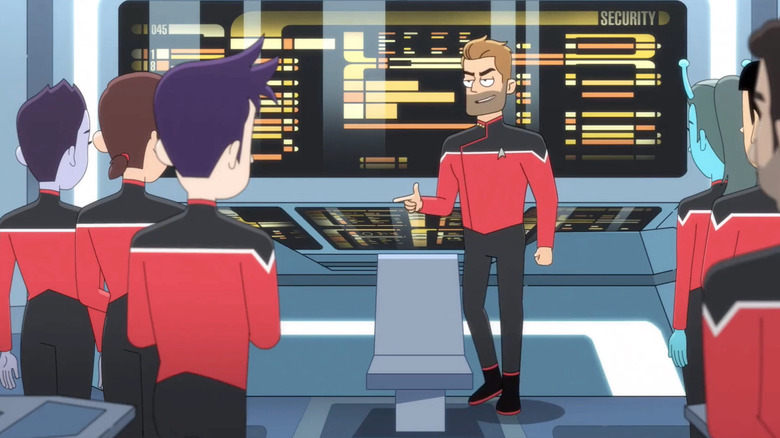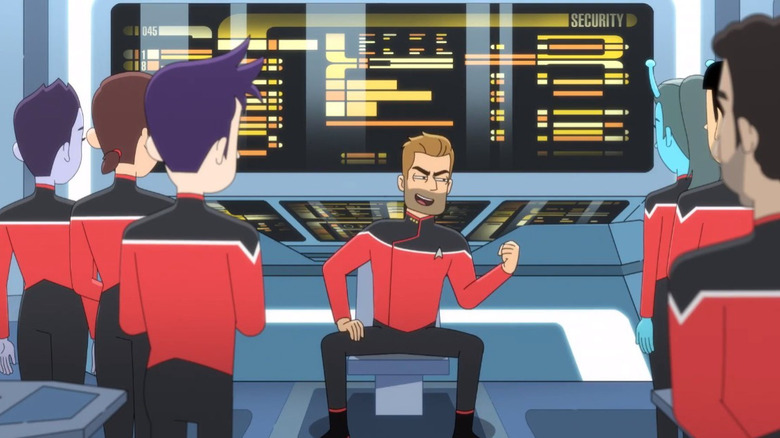Star Trek: Lower Decks Finally Got Around To Referencing An Infamous Next Generation Easter Egg
Warning: The following article contains spoilers for the "Star Trek: Lower Decks" season 3 finale.
In "Star Trek," there are two phenomena called the Picard Maneuver. Within Trek canon, the maneuver was a clever tactical strategy meant to be employed in close-up, ship-to-ship battle. The idea was that if a Starfleet vessel were to throw itself into warp speed for a split second, zipping toward their opponent, it would temporarily look like there were two ships. The invention of the Picard Maneuver was discussed in the "Star Trek: The Next Generation" episode "The Battle" (November 16, 1987). In fandom, the Picard Maneuver is the given nickname for the small, waist-level, two-handed downward tug that actor Patrick Stewart gave to the front of his costume whenever he stood up.
Likewise with the Riker Maneuver. In "Star Trek: Insurrection," Cmdr. Riker (Jonathan Frakes) steers the Enterprise-E through a cloud of unstable, explosive cosmic gasses. The Bussard ramscoops (that is: the glowing red tips on the ship's nacelles) suck in the gasses for storage. Riker then sprays the gas on an attacking ship, igniting it with a photon torpedo. The Riker Maneuver doesn't seem like an effective tactical practice, however, as it would require a ship to be immediately nearby a cloud of unstable, explosive cosmic gasses to work. Also, igniting explosive gasses seems like it would do just as much damage to your own ship as to an enemy.
In fandom, however, the Riker Maneuver refers to the phenomenon of actor Frakes' peculiar method of sitting down by swinging his leg over the back of a chair and squatting on it.
The secondary definition of the Riker Maneuver just became Trek canon in the latest episode of "Star Trek: Lower Decks."
The Riker Maneuver
The plot of the latest episode of "Star Trek: Lower Decks," called "The Stars at Night," pits the U.S.S. Cerritos, a California-class ship, against the U.S.S. Aledo, the first of three Texas-class ships that operate on A.I. and carry no crew aboard. Capt. Freeman (Dawnn Lewis) feels that automated ships simply don't have the capacity for practical humanitarian missions, and wants to prove that her own scrappy crew can out-do anything the Aledo can do. This requires a quick, bustling crunch time wherein the entire crew scrambles to prepare for the face-off. Dr. T'Ana (Gillian Vigman) screams at everyone in sickbay waving a riding crop. Lt. Cmdr. Billups (Paul Scheer) barks that all his engineers need to be at the ready for anything. And Cmdr. Jack Ransom (Jerry O'Connell) advises all the Cerritos' future commanders on how to better lead.
Hilariously, part of Ransom's last-minute reminders involve teaching his officers how to properly execute a Riker Maneuver. No, not the tactical one — the sitting down one. He shows his officers how to lift a leg over the back of a chair and sit commandingly in it. "Command the chair," he says gruffly. This is a cute in-joke for Trekkies, but also shows the small ways that minor character behavior on "Star Trek" comes to be admired by the people who followed.
Jonathan Frakes' spine
As it so happens, the now-famous Riker Maneuver was invented for practical reasons. Jonathan Frakes is a tall man, standing 6'3". The furniture on "Star Trek: The Next Generation" consisted of low stools, and a lot of smaller, spindly, low-backed office chairs. For a 6'3" man, such chair would be awkward for him to sit down in with dignity. The swagger-forward leg-swing seems visually more dynamic and actually speaks to the confidence of the character.
It was also a maneuver adopted to save Frakes a great deal of pain. As was once explained in the Mary Sue, Frakes once worked for a moving company, and spent days lifting heavy objects. At some point during that job, Frakes sustained a back injury that made the act of lowing himself down into a chair painful for him. Keeping his spine straight and squatting down on a chair was easier for him, so he merely incorporated that into his character. Wil Wheaton, the actor who played Wesley Crusher, confirmed this. One might also notice that Riker had a way of leaning on consoles or desks, often bringing himself closer to the person he was talking to. This seemed like it was a way to intimidate and command attention, but it was, again, Frakes merely saving his back.
It is a strange string of events. Long ago, an actor sustained an injury while lifting a couch. Decades later, an animated character is teaching people how to sit properly based on that injury.

